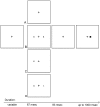Exogenous visual orienting is associated with specific neurotransmitter genetic markers: a population-based genetic association study
- PMID: 22348020
- PMCID: PMC3279352
- DOI: 10.1371/journal.pone.0030731
Exogenous visual orienting is associated with specific neurotransmitter genetic markers: a population-based genetic association study
Abstract
Background: Currently, there is a sense that the spatial orienting of attention is related to genotypic variations in cholinergic genes but not to variations in dopaminergic genes. However, reexamination of associations with both cholinergic and dopaminergic genes is warranted because previous studies used endogenous rather than exogenous cues and costs and benefits were not analyzed separately. Examining costs (increases in response time following an invalid pre-cue) and benefits (decreases in response time following a valid pre-cue) separately could be important if dopaminergic genes (implicated in disorders such as attention deficit disorder) independently influence the different processes of orienting (e.g., disengage, move, engage).
Methodology/principal findings: We tested normal subjects (N = 161) between 18 and 61 years. Participants completed a computer task in which pre-cues preceded the presence of a target. Subjects responded (with a key press) to the location of the target (right versus left of fixation). The cues could be valid (i.e., appear where the target would appear) or invalid (appear contralateral to where the target would appear). DNA sequencing assays were performed on buccal cells to genotype known genetic markers and these were examined for association with task scores. Here we show significant associations between visual orienting and genetic markers (on COMT, DAT1, and APOE; R(2)s from 4% to 9%).
Conclusions/significance: One measure in particular--the response time cost of a single dim, invalid cue - was associated with dopaminergic markers on COMT and DAT1. Additionally, variations of APOE genotypes based on the ε2/ε3/ε4 alleles were also associated with response time differences produced by simultaneous cues with unequal luminances. We conclude that individual differences in visual orienting are related to several dopaminergic markers as well as to a cholinergic marker. These results challenge the view that orienting is not associated with genotypic variation in dopaminergic genes.
Conflict of interest statement
Figures






Similar articles
-
Dopaminergic haplotype as a predictor of spatial inattention in children with attention-deficit/hyperactivity disorder.Arch Gen Psychiatry. 2009 Oct;66(10):1135-42. doi: 10.1001/archgenpsychiatry.2009.120. Arch Gen Psychiatry. 2009. PMID: 19805704
-
Neural correlates of the spatial and expectancy components of endogenous and stimulus-driven orienting of attention in the Posner task.Cereb Cortex. 2010 Jul;20(7):1574-85. doi: 10.1093/cercor/bhp215. Epub 2009 Oct 21. Cereb Cortex. 2010. PMID: 19846472
-
Deconstructing Reorienting of Attention: Cue Predictiveness Modulates the Inhibition of the No-target Side and the Hemispheric Distribution of the P1 Response to Invalid Targets.J Cogn Neurosci. 2020 Jun;32(6):1046-1060. doi: 10.1162/jocn_a_01534. Epub 2020 Jan 22. J Cogn Neurosci. 2020. PMID: 31967519
-
Modulating the attentional bias in unilateral neglect: the effects of the strategic set.Exp Brain Res. 2001 Apr;137(3-4):432-44. doi: 10.1007/s002210000642. Exp Brain Res. 2001. PMID: 11355388
-
Orienting of visual attention in aging.Neurosci Biobehav Rev. 2016 Oct;69:357-80. doi: 10.1016/j.neubiorev.2016.08.010. Epub 2016 Aug 13. Neurosci Biobehav Rev. 2016. PMID: 27531234 Review.
Cited by
-
The SLC6A3 gene polymorphism is related to the development of attentional functions but not to ADHD.Sci Rep. 2020 Apr 10;10(1):6176. doi: 10.1038/s41598-020-63296-x. Sci Rep. 2020. PMID: 32277231 Free PMC article.
-
A systematic review and meta-analysis of the relationship between genes and reflexive attention.Front Neurosci. 2025 May 30;19:1449354. doi: 10.3389/fnins.2025.1449354. eCollection 2025. Front Neurosci. 2025. PMID: 40520502 Free PMC article.
-
Genetic associations with reflexive visual attention in infancy and childhood.Dev Sci. 2017 May;20(3):10.1111/desc.12371. doi: 10.1111/desc.12371. Epub 2015 Nov 27. Dev Sci. 2017. PMID: 26613685 Free PMC article.
-
Neurochemistry of Visual Attention.Front Neurosci. 2021 May 5;15:643597. doi: 10.3389/fnins.2021.643597. eCollection 2021. Front Neurosci. 2021. PMID: 34025339 Free PMC article. Review.
-
Relating dopaminergic and cholinergic polymorphisms to spatial attention in infancy.Dev Psychol. 2014 Feb;50(2):360-9. doi: 10.1037/a0033172. Epub 2013 Jun 3. Dev Psychol. 2014. PMID: 23731290 Free PMC article.
References
-
- Green AE, Munafò MR, DeYoung CG, Fossella JA, Fan J, Gray JR. Using genetic data in cognitive neuroscience: From growing pains to genuine insights. Nature Reviews Neuroscience. 2008;9:710–720. - PubMed
-
- Landry R, Bryson S. Impaired disengagement of attention in young children with autism. Journal of Child Psychology and Psychiatry. 2004;45:1115–1122. - PubMed
-
- Øie M, Rund BR, Sundet K. Covert visual attention in patients with early-onset schizophrenia. Schizophrenia Research. 1998;24:195–205. - PubMed
Publication types
MeSH terms
Substances
Grants and funding
LinkOut - more resources
Full Text Sources
Miscellaneous

